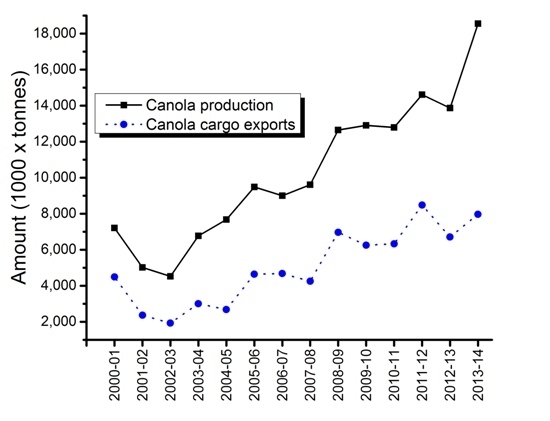Comparison between Canadian Canola Harvest and Export Surveys
Abstract
:1. Introduction
2. Results and Discussion
2.1. Harvest Survey Data
2.2. Oil Content
2.3. Protein Content
2.4. Glucosinolates Content
2.5. Chlorophyll Content
2.6. Free Fatty Acid Content of the Oil
2.7. Fatty Acid Composition of the Oil
3. Material and Methods
3.1. Harvest Data
3.2. Export Data
3.3. Methods
3.4. Statistic and Analysis
4. Conclusions
Acknowledgments
Conflicts of Interest
References
- Official Grain Grading Guide—Canola and Rapeseed, Chapter 10. Available online: http://www.grainscanada.gc.ca/oggg-gocg/10/oggg-gocg-10-eng.htm (accessed on 5 February 2016).
- Estimated Areas, Yield and Production of Principal Field Crops by Small Area Data Regions, in Metric and Imperial Units Annual. Available online: http://www5.statcan.gc.ca/cansim/a26?lang=eng&retrLang=eng&id=0010071&paSer=&pattern=&stByVal=1&p1=1&p2=31&tabMode=dataTable&csid (accessed on 12 February 2016).
- DeClercq, D.R.; Daun, J.K. Canadian Canola Quality Parameters: Comparison of Results from Harvest and Export Surveys. International Consultative Group for Research on Rapeseed. 2005. Available online: http://gcirc.org/fileadmin/documents/Bulletins/B22/Canadian_Canola_Quality_Parameters.pdf (accessed on 15 April 2016).
- Siemens, B.; Daun, J.K. Contribution of Dockage (Admixture) to the Chlorophyll Content of Canadian Canola exports. International Consultative Group for Research on Rapeseed. 2005. Available online: http://gcirc.org/fileadmin/user_upload/Contribution_of_Dockage.pdf (accessed on 15 April 2016).
- Daun, J.K.; Symons, S. How green is green? Sampling and perception in assessing green seeds and chlorophyll in Canola. J. Am. Oil Chemists’ Soc. 2000, 77, 1209–1214. [Google Scholar] [CrossRef]
- Daun, J.K. How green is green? Long term relationship between green seed and chlorophyll in Canola grading. J. Am. Oil Chemists’ Soc. 2003, 80, 119–122. [Google Scholar] [CrossRef]
- American Oil Chemists’ Society method number Ba 4e-93. Generic Combustion Method for Determination of Crude Protein, revised in 2011. Available online: http://methods.aocs.igx.rd.net/methods/search-results?method=111449&keywords= (accessed on 19 July 2016).
- International Organization for Standardization—ISO 10565:1998 Oilseeds—Simultaneous determination of oil and water contents—Method using pulsed nuclear magnetic resonance spectrometry. Available online: http://www.iso.org/iso/catalogue_detail.htm?csnumber=26317 (accessed on 19 July 2016).
- International Organization for Standardization—ISO 659:2009—Oilseeds—Determination of oil content (Reference method). Available online: http://www.iso.org/iso/iso_catalogue/catalogue_tc/catalogue_detail.htm?csnumber=43169 (accessed on 19 July 2016).
- International Organization for Standardization—ISO 9167–3—Oilseeds—Rapeseed—Determination of glucosinolates content—Part 3: Spectrophotometric method using glucose release. Removed from the ISOTC34SC2, the standard will be change to a technical document and will have a new number. Available online: http://www.iso.org/iso/home/store/catalogue_tc/catalogue_tc_browse.htm?commid=47870 (accessed on 19 July 2016).
- International Organization for Standardization—ISO 10519:1997—Rapeseed—Determination of chlorophyll content—Spectrometric method. Available online: http://www.iso.org/iso/iso_catalogue/catalogue_tc/catalogue_detail.htm?csnumber=22763 (accessed on 19 July 2016).
- International Organization for Standardization—ISO 12966–2:2011. Animal and vegetable fats and oils—Gas chromatography of fatty acid methyl esters—Part 2: Preparation of methyl esters of fatty acids. Available online: http://www.iso.org/iso/home/store/catalogue_tc/catalogue_detail.htm?csnumber=43172 (accessed on 19 July 2016).
- International Organization for Standardization—ISO 12966–1:2014 Animal and vegetable fats and oils —Gas chromatography of fatty acid methyl esters—Part 1: Guidelines on modern gas chromatography of fatty acid methyl esters. Available online: http://www.iso.org/iso/catalogue_detail.htm?csnumber=52294 (accessed on 19 July 2016).
- American Oil Chemists’ Society method number Cd 1c-85. Calculated Iodine Value, reapproved in 2009. Available online: http://search.aocs.org/methods/search_methods_results.cfm (accessed on 19 July 2016).
- Ke, P.J.; Woyewoda, A.D. A titrimetric method for determination of free fatty acids in tissues and lipids with ternary solvents and m-cresol purple indicator. Anal. Chim. Acta 1978, 99, 387–391. [Google Scholar] [CrossRef]
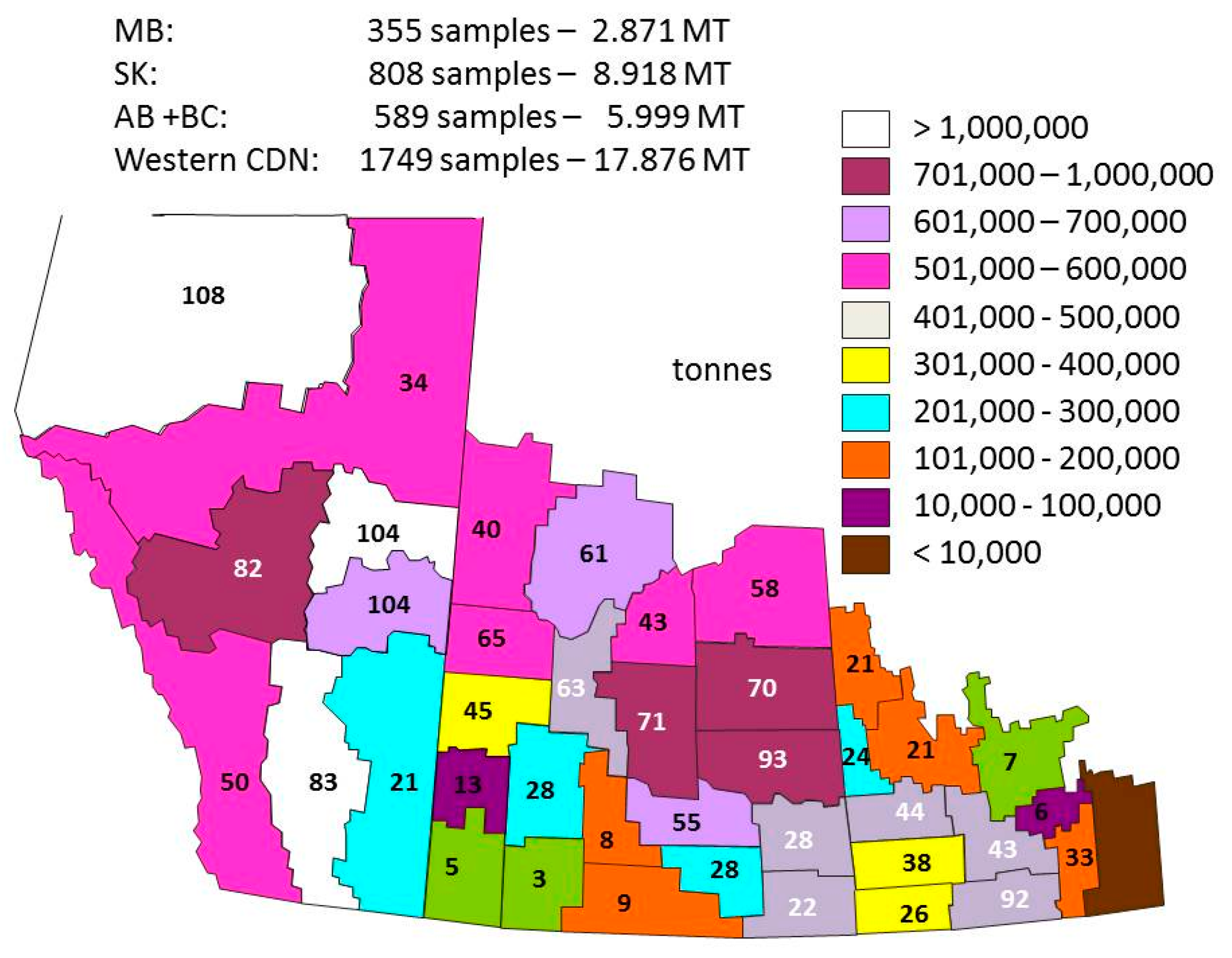
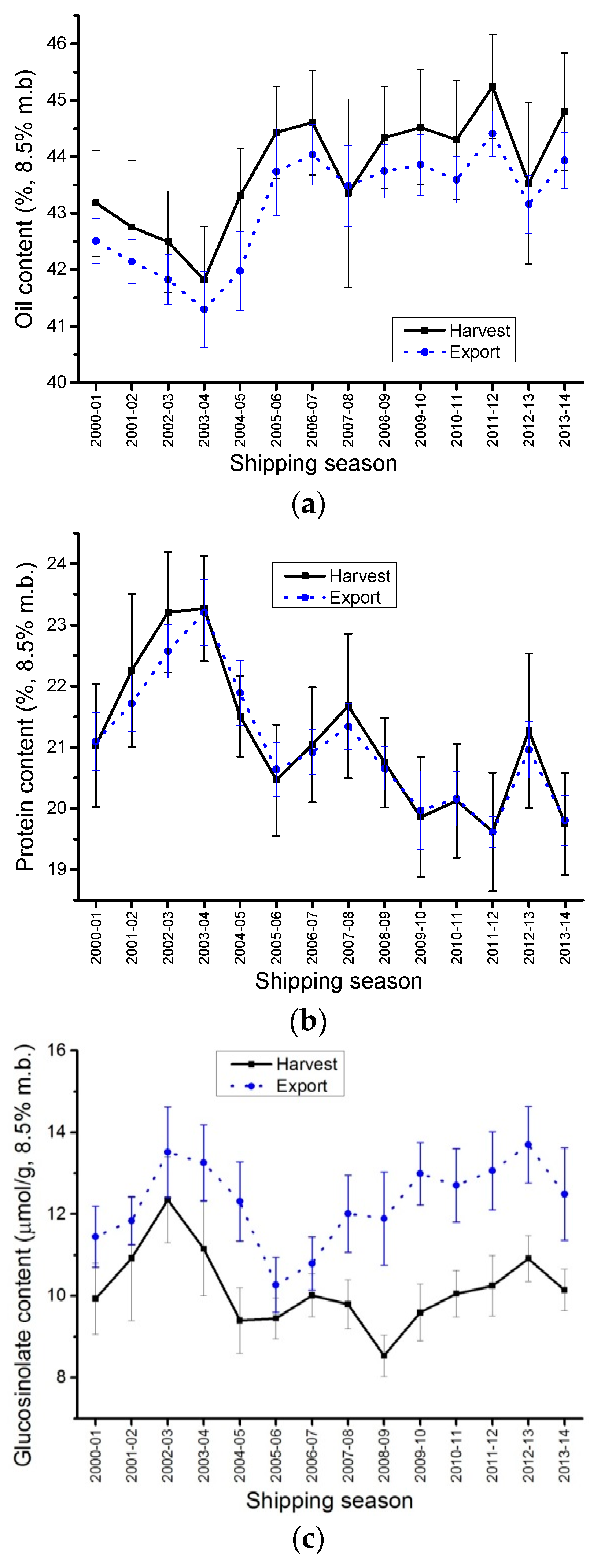
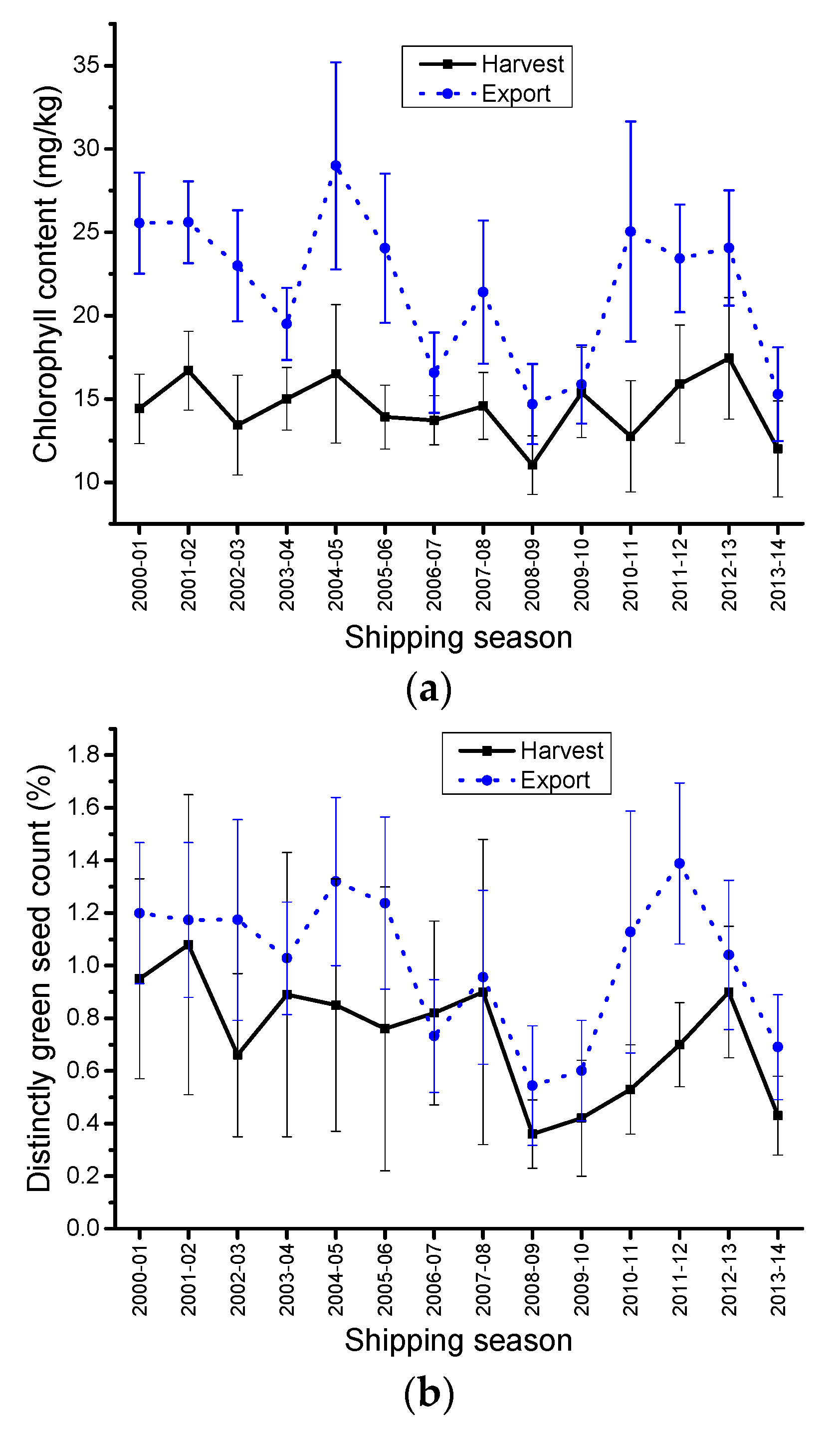
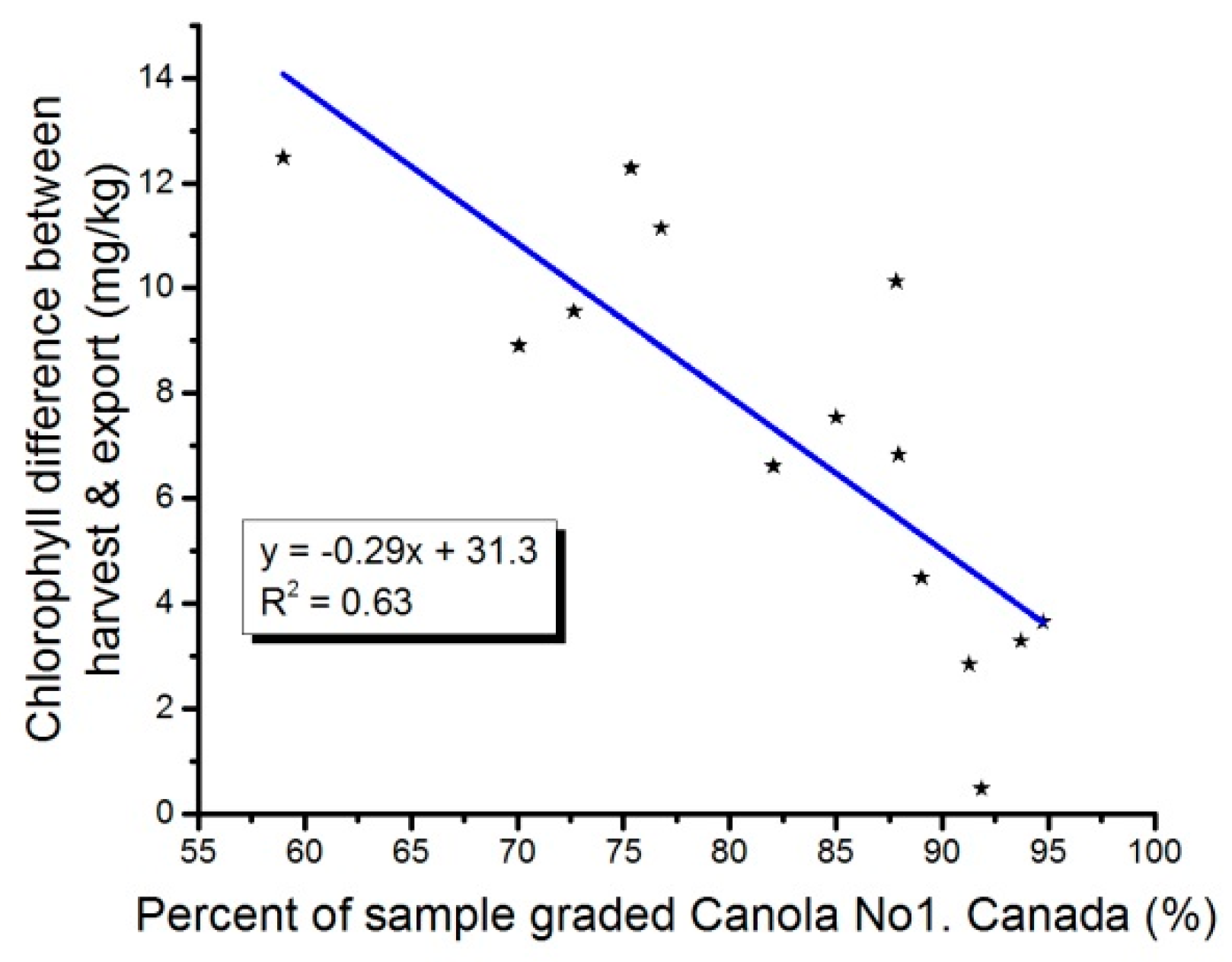
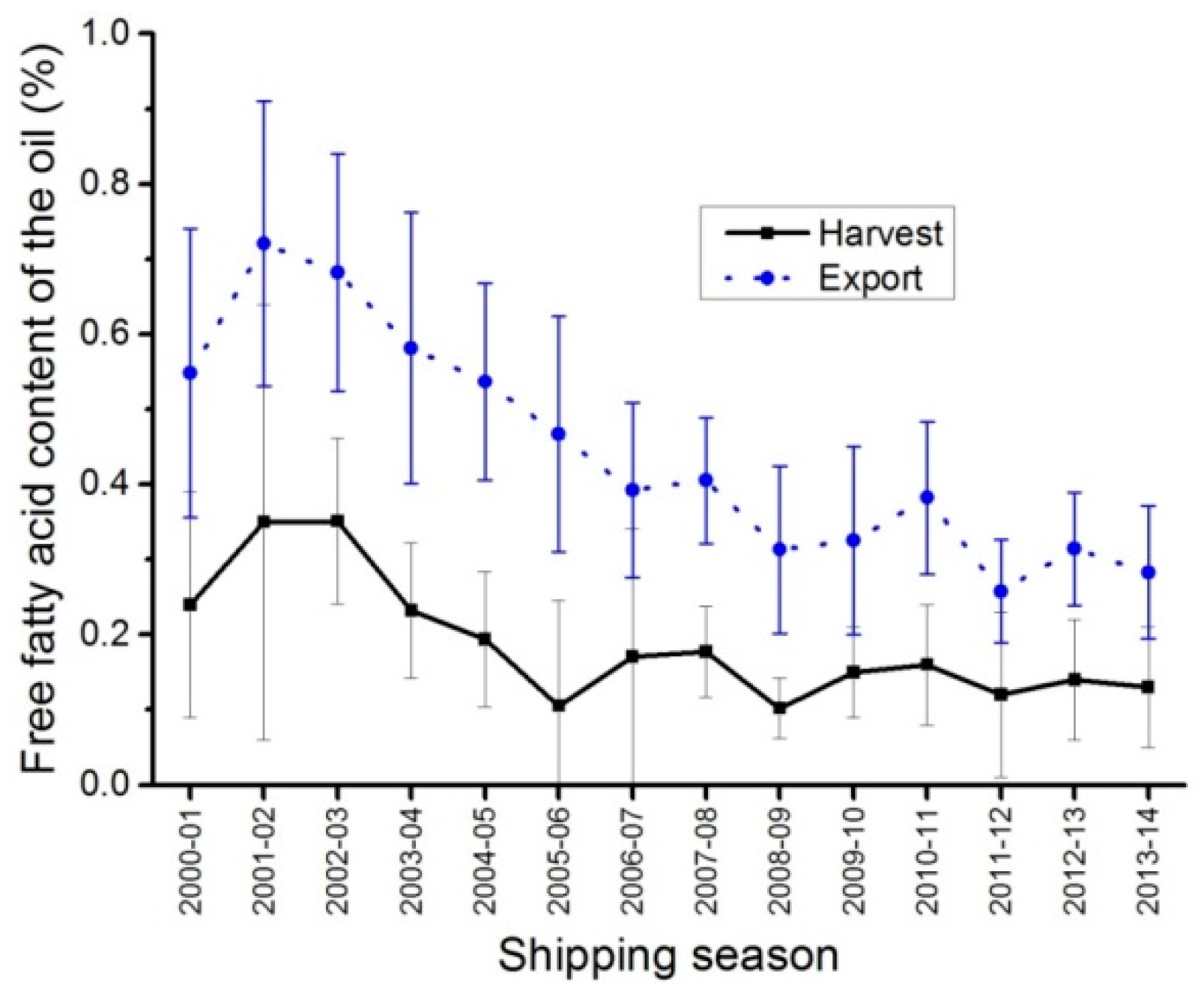
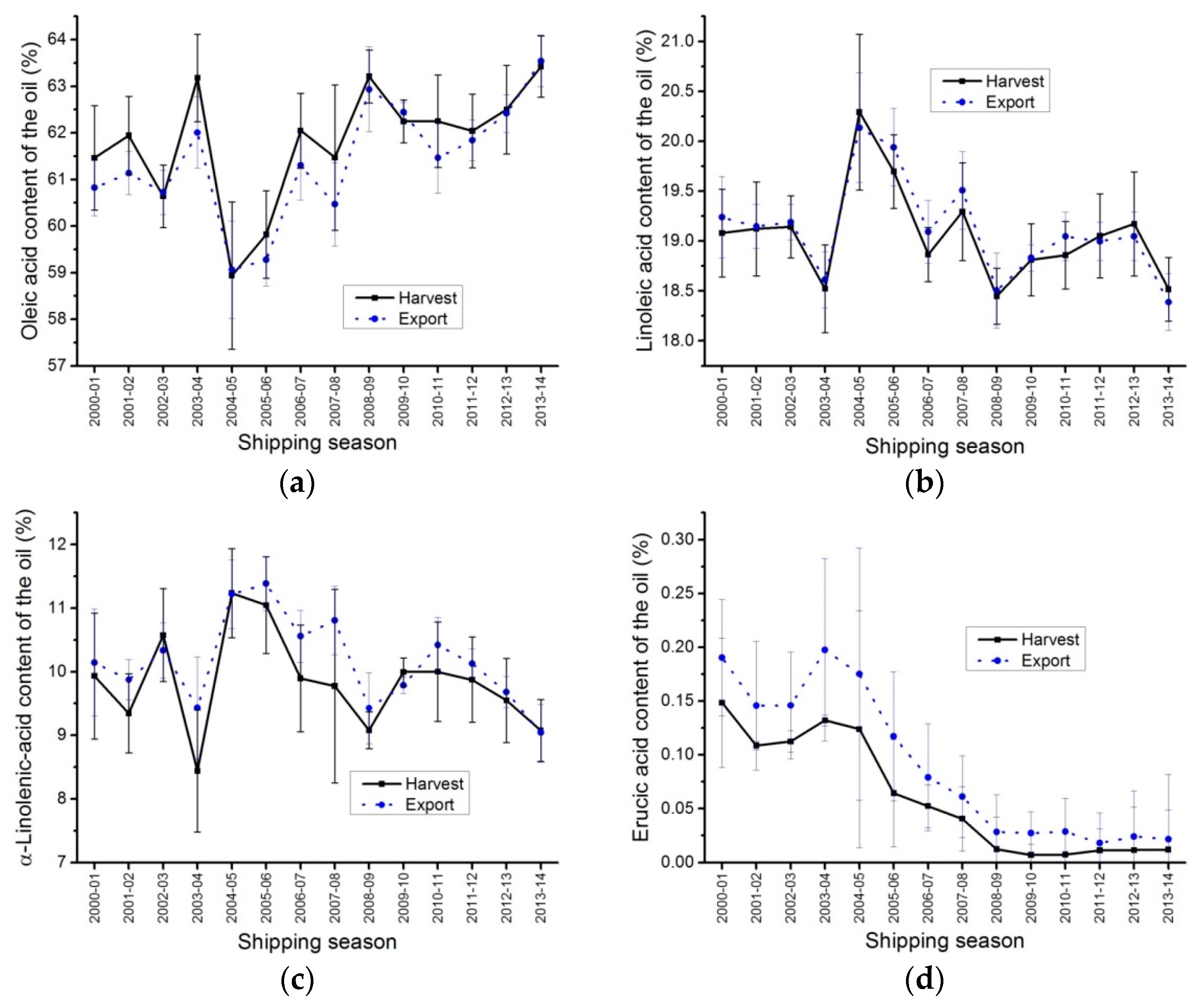
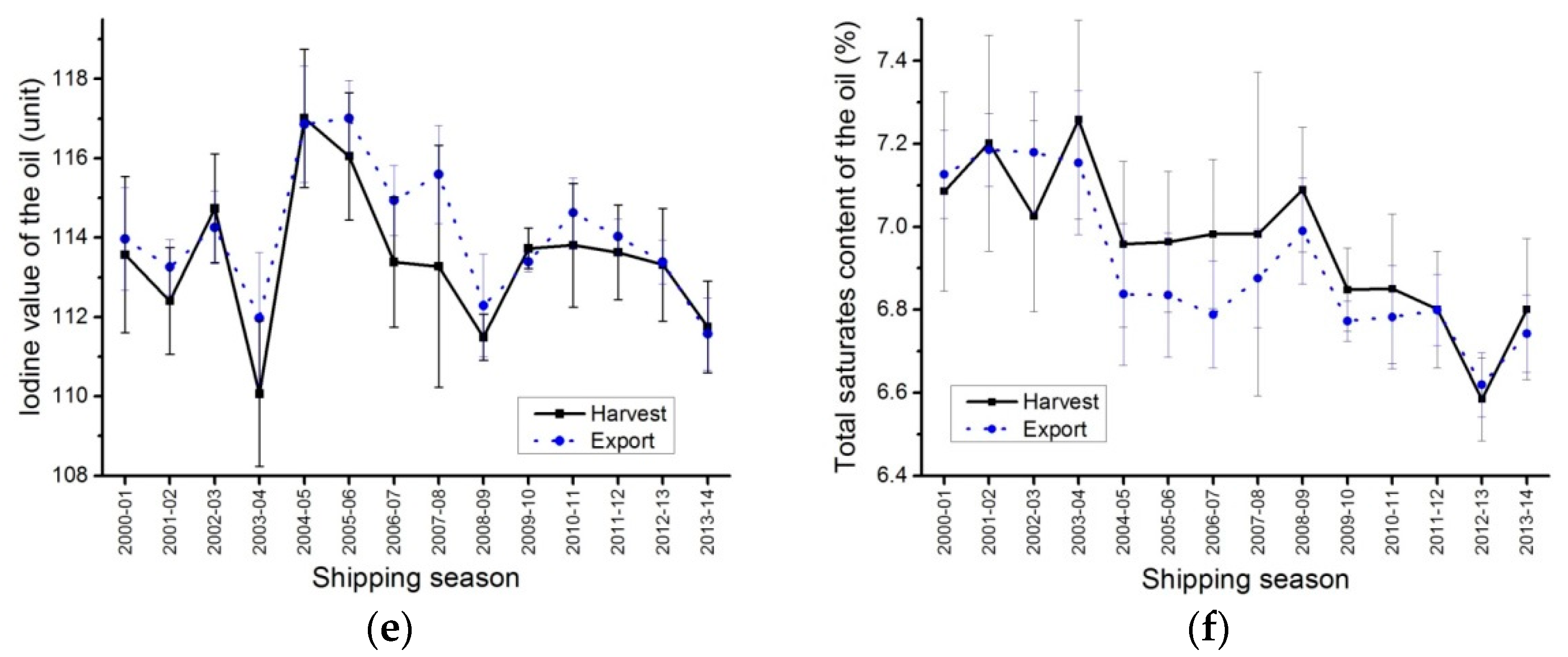
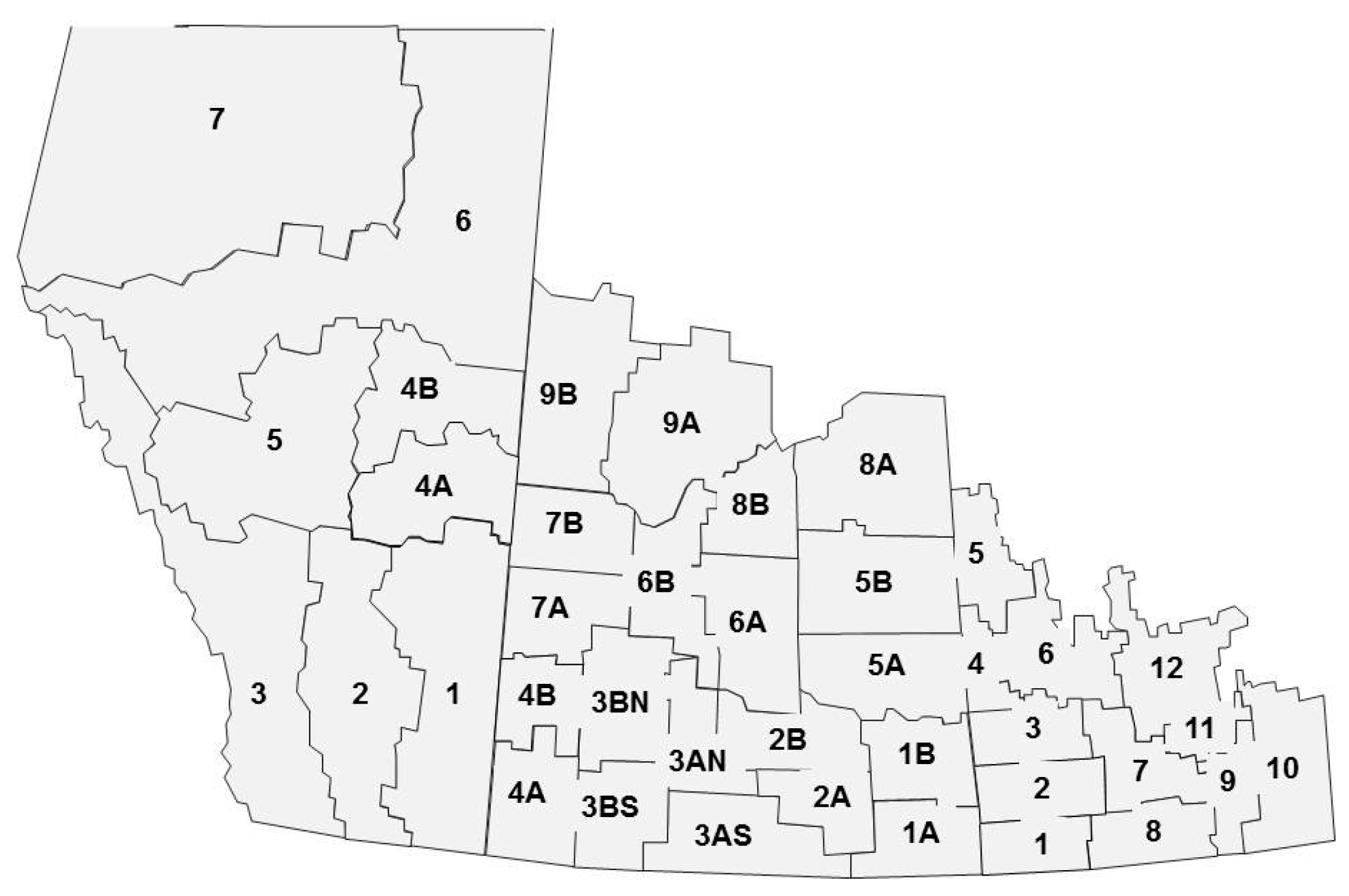
| Year of Harvest | Shipping Season | Canada Production (Tonnes) * | Number of Samples in Harvest Survey (NH) | Percent of Canola, No.1 Canada (NH1) | Number of Cargoes (NE) | Total Export (Tonnes) | Export Average (Tonnes) | Minimum Export Tonnage (Tonnes) | Maximum Export Tonnage (Tonnes) | Dockage (%) |
|---|---|---|---|---|---|---|---|---|---|---|
| 2000 | 2000–01 | 7,205,300 | 1386 | 76.77 | 148 | 4,180,554 | 28,246.99 | 498 | 57,750 | 1.97 ± 0.21 |
| 2001 | 2001–02 | 5,017,100 | 1343 | 70.07 | 97 | 2,244,769 | 23,141.93 | 848 | 52,376 | 1.96 ± 0.30 |
| 2002 | 2002–03 | 4,520,500 | 1266 | 72.67 | 83 | 1,683,828 | 20.287.08 | 4200 | 51,569 | 1.90 ± 0.27 |
| 2003 | 2003–04 | 6,771,200 | 2203 | 89.01 | 114 | 2,695,243 | 23,642.48 | 2100 | 56,500 | 1.88 ± 0.21 |
| 2004 | 2004–05 | 7,673,600 | 1943 | 58.98 | 100 | 2,240,216 | 22,402.16 | 3489 | 55,002 | 1.80 ± 0.25 |
| 2005 | 2005–06 | 9,483,300 | 2186 | 87.83 | 158 | 4,270,430 | 27,028.04 | 2000 | 60,500 | 1.69 ± 0.38 |
| 2006 | 2006–07 | 9,000,300 | 2485 | 91.27 | 149 | 3,880,916 | 26,046.42 | 3290 | 60,500 | 1.86 ± 0.27 |
| 2007 | 2007–08 | 9,611,300 | 2114 | 87.94 | 151 | 3,609,326 | 23,902.82 | 2017 | 65,253 | 1.94 ± 0.20 |
| 2008 | 2008–09 | 12,644,900 | 1767 | 94.74 | 196 | 6,351,669 | 32,406.47 | 3833 | 65,879 | 1.77 ± 0.29 |
| 2009 | 2009–10 | 12,898,100 | 1362 | 91.85 | 183 | 5,678,678 | 31,031.03 | 3249 | 65,556 | 1.91 ± 0.35 |
| 2010 | 2010–11 | 12,788,600 | 1785 | 75.35 | 169 | 5,161,053 | 30,538.78 | 1900 | 63,225 | 1.88 ± 0.28 |
| 2011 | 2011–12 | 14,608,100 | 1749 | 85.02 | 193 | 6,465,592 | 33,500.48 | 3427 | 69,550 | 1.89 ± 0.27 |
| 2012 | 2012–13 | 13,868,500 | 2089 | 82.05 | 168 | 5,080,798 | 30,242.85 | 1236 | 63,800 | 1.99 ± 0.27 |
| 2013 | 2013–14 | 17,965,800 | 1588 | 93.70 | 192 | 7,190,048 | 37,448.17 | 5250 | 66,000 | 1.92 ± 0.40 |
| Production (Tonnes) | Number of Samples in Harvest Survey | ||||||
|---|---|---|---|---|---|---|---|
| Census Ag Region | Canola Crop District | Mean | Min. | Max. | Mean | Min. | Max. |
| Manitoba | |||||||
| 1 | 1 | 206,779 | 72,478 | 376,485 | 46 | 11 | 74 |
| 2 | 2 | 193,470 | 119,699 | 321,300 | 54 | 21 | 86 |
| 3 | 3 | 231,997 | 136,492 | 450,600 | 57 | 36 | 85 |
| 4 | 4 | 95,743 | 51,346 | 212,900 | 35 | 23 | 52 |
| 5 | 5 | 156,529 | 94,986 | 202,250 | 27 | 17 | 40 |
| 6 | 6 | 137,766 | 87,162 | 228,942 | 38 | 21 | 54 |
| 7 | 7 | 257,834 | 100,567 | 436,800 | 61 | 9 | 95 |
| 8 | 8 | 360,678 | 192,968 | 560,406 | 95 | 49 | 139 |
| 9 + 10 | 9 + 10 | 92,842 | 15,313 | 145,012 | 38 | 14 | 62 |
| 11 | 11 | 65,398 | 19,136 | 102,257 | 16 | 6 | 31 |
| 12 | 12 | 55,403 | 23,374 | 86,500 | 10 | 3 | 17 |
| Manitoba | 1,854,443 | 1,122,600 | 2,871,200 | 476 | 332 | 662 | |
| Saskatchewan | |||||||
| 11 + 12 | 1 | 389,742 | 120,331 | 902,800 | 72 | 20 | 111 |
| 21 + 22 | 2 | 295,099 | 85,754 | 878,400 | 71 | 41 | 94 |
| 31 + 32 + 33 + 34 | 3 | 204,586 | 55,722 | 658,700 | 45 | 17 | 80 |
| 41 + 42 | 4 | 34,209 | 4064 | 114,500 | 9 | 3 | 15 |
| 51 + 52 | 5 | 911,496 | 495,214 | 1,696,200 | 172 | 129 | 231 |
| 61 + 62 | 6 | 729,810 | 221,867 | 1,316,600 | 141 | 94 | 203 |
| 71 + 72 | 7 | 376,404 | 38,217 | 918,600 | 79 | 22 | 115 |
| 81 + 82 | 8 | 752,037 | 209,092 | 1,390,130 | 127 | 75 | 184 |
| 91 + 92 | 9 | 723,526 | 81,082 | 1,245,800 | 119 | 45 | 158 |
| Saskatchewan | 4,414,900 | 1,769,000 | 8,917,600 | 835 | 571 | 1085 | |
| Alberta + British Columbia | |||||||
| 10 | 1 | 85,002 | 17,189 | 218,134 | 12 | 4 | 19 |
| 20 | 2 | 540,415 | 116,814 | 1,154,993 | 81 | 37 | 117 |
| 30 | 3 + 1 * | 229,430 | 37,760 | 546,300 | 44 | 12 | 67 |
| 40 | 4A + 4B | 938,368 | 133,001 | 1,717,600 | 193 | 62 | 262 |
| 50 | 5 | 492,696 | 164,888 | 771,400 | 62 | 32 | 97 |
| 60 | 6 | 342,346 | 148,350 | 590,500 | 33 | 21 | 46 |
| 70 | 7 + 8 ** | 694,917 | 452,849 | 1,188,600 | 91 | 50 | 130 |
| AB + BC | 3,470,600 | 1,242,800 | 6,087,500 | 517 | 274 | 677 | |
| Canada | 9,739,943 | 4,463,300 | 17,876,300 | 1827 | 1300 | 2337 | |
| Distinctly Green Seeds (%) | Oil Content (%, 8.5% m.b.) | Protein Content (%, 8.5% m.b.) | Chlorophyll Content (mg/kg) | |||||
|---|---|---|---|---|---|---|---|---|
| Harvest | Export | Harvest | Export | Harvest | Export | Harvest | Export | |
| Average | 0.73 | 1.02 | 43.76 | 43.12 | 21.13 | 21.04 | 14.48 | 21.64 |
| Standard deviation | 0.22 | 0.27 | 0.99 | 0.98 | 1.18 | 1.04 | 1.84 | 4.52 |
| Minimum | 0.36 | 0.54 | 41.82 | 41.30 | 19.62 | 19.61 | 11.03 | 14.68 |
| Maximum | 1.08 | 1.39 | 45.24 | 44.41 | 23.27 | 23.20 | 17.43 | 28.99 |
| Median | ||||||||
| Paired t-test—Two tail p value—Results | ||||||||
| Mean difference | −0.28540 | 0.64000 | 0.09286 | −7.16300 | ||||
| p value | 0.0005 | 0.00010 | 0.23670 | <0.0001 | ||||
| t | 4.322 | 7.674 | 1.240 | 7.078 | ||||
| Total Glucosinolates Content of the Seeds (µmol/g) | Free Fatty Acid Content of the Oil (%) | Iodine Value of the Oil (Units) | Total Saturates Content of the Oil (%) | |||||
|---|---|---|---|---|---|---|---|---|
| Harvest | Exports | Harvest | Export | Harvest | Export | Harvest | Exports | |
| Average | 10.18 | 12.31 | 0.19 | 0.44 | 113.45 | 114.08 | 6.96 | 6.91 |
| Standard deviation | 0.93 | 1.01 | 0.08 | 0.15 | 1.77 | 1.65 | 0.18 | 0.19 |
| Minimum | 8.53 | 10.27 | 0.10 | 0.26 | 110.07 | 111.57 | 6.58 | 6.62 |
| Maximum | 12..35 | 13.7 | 0.35 | 0.72 | 117.01 | 117.01 | 7.26 | 7.18 |
| Median | 10.03 | 12.4 | 0.16 | 0.40 | 113.48 | 114.00 | 6.97 | 6.84 |
| Paired t-test—Two tail p value Results | ||||||||
| Mean difference | −2.13 | −0.2564 | −0.6371 | 0.05286 | ||||
| p value | <0.0001 | <0.0001 | 0.0150 | 0.0410 | ||||
| t | 8.551 | 11.336 | 2.802 | 2.268 | ||||
| Oleic Acid Content of the Oil (C18:1, %) | Linoleic Acid Content of the Oil (C18:2, %) | α-Linolenic Acid Content of the Oil (C18:3, %) | Erucic Acid Content of the Oil (C22:1, %) | |||||
|---|---|---|---|---|---|---|---|---|
| Harvest | Export | Harvest | Export | Harvest | Export | Harvest | Export | |
| Average | 61.80 | 61.39 | 19.06 | 19.12 | 9.84 | 10.16 | 0.06 | 0.09 |
| Standard deviation | 1.28 | 1.28 | 0.49 | 0.49 | 0.76 | 0.68 | 0.05 | 0.07 |
| Minimum | 58.94 | 59.07 | 18.45 | 18.39 | 8.44 | 9.04 | 0.01 | 0.02 |
| Maximum | 63.43 | 63.54 | 20.29 | 20.14 | 11.24 | 11.38 | 0.15 | 0.20 |
| Median | 62.04 | 61.38 | 19.07 | 19.07 | 9.88 | 10.14 | 0.04 | 0.07 |
| Paired t-test—Two tail p value—Results | ||||||||
| Mean difference | 0.4093 | −0.05857 | −0.3157 | −0.03214 | ||||
| p value | 0.0054 | 0.1300 | 0.0104 | <0.0001 | ||||
| t | 3.334 | 1.616 | 2.993 | 5.993 | ||||
© 2016 by the author; licensee MDPI, Basel, Switzerland. This article is an open access article distributed under the terms and conditions of the Creative Commons Attribution (CC-BY) license (http://creativecommons.org/licenses/by/4.0/).
Share and Cite
Barthet, V.J. Comparison between Canadian Canola Harvest and Export Surveys. Plants 2016, 5, 30. https://doi.org/10.3390/plants5030030
Barthet VJ. Comparison between Canadian Canola Harvest and Export Surveys. Plants. 2016; 5(3):30. https://doi.org/10.3390/plants5030030
Chicago/Turabian StyleBarthet, Véronique J. 2016. "Comparison between Canadian Canola Harvest and Export Surveys" Plants 5, no. 3: 30. https://doi.org/10.3390/plants5030030
APA StyleBarthet, V. J. (2016). Comparison between Canadian Canola Harvest and Export Surveys. Plants, 5(3), 30. https://doi.org/10.3390/plants5030030




